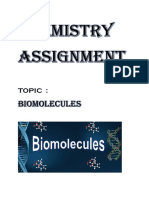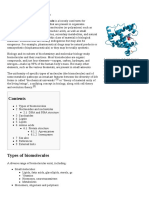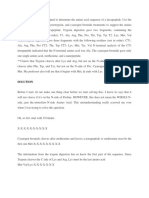M1 Lesson 1: Introduction To Biochemistry Part 3
Uploaded by
CHARLES RONALD GENATOM1 Lesson 1: Introduction To Biochemistry Part 3
Uploaded by
CHARLES RONALD GENATOM1 Lesson 1: Introduction to Biochemistry Part 1 How did living things originate?
Introduction to Biochemistry
How did the components of our bodies come to be
Living organisms, such as humans, and even the and to do the things that they do? What are the
individual cells of which they are composed, are molecules of life?
enormously complex and diverse. Nevertheless,
certain unifying features are common to all living Even the structures of comparatively small
things from the simplest bacterium to the human biomolecules consist of several parts. Large
being. They all use the same types of biomolecules, biomolecules, such as proteins and nucleic acids,
and they all use energy. As a result, organisms can be have complex structures, and living cells are
studied via the methods of chemistry and physics. enormously more complex. Even so, both molecules
and cells must have arisen ultimately from very
simple molecules, such as water, methane, carbon
dioxide, ammonia, nitrogen, and hydrogen (see
figure above). In turn, these simple molecules must
have arisen from atoms.
The way in which the Universe itself, and the atoms
of which it is composed, came to be is a topic of
great interest to astrophysicists as well as other
scientists. Simple molecules were formed by
On the figure above, we focus on the connection combining atoms, and reactions of simple molecules
between biomolecules and chemistry, because that led in turn to more complex molecules. The
is the part where Biochemistry comes into play. molecules that play a role in living cells today are the
same molecules as those encountered in organic
M1 Lesson 1: Introduction to Biochemistry Part 2 chemistry; they simply operate in a different context.
Biochemistry M1 Lesson 1: Introduction to Biochemistry Part
Biochemistry comes from the terms “Bios” (meaning, 3
life) and Chemistry, the study of matter.
Biochemistry is the science of the chemical basis of
life. It deals with the study of the chemical
constituents of living cells and the reactions and
processes they undergo.
NOTE: The major aim of biochemistry is to describe
the structure, organization, and functions of living
matter in molecular terms.
to living cells at the molecular level that's
associated with drug action.
2) Biochemistry helps to acquire data on the
adverse effects, molecular targets, &
characterization of medicine or different
chemical substance within the living cells &
M1 Lesson 1: Introduction to Biochemistry Part organisms.
4
Essence of Biochemistry in Life Sciences M1 Lesson 2: Introduction to Biomolecules Part
1
Biomolecules are molecules that occur naturally
in living organisms
consists mainly of carbon and hydrogen
with nitrogen, oxygen, sulphur, and
phosphorus.
very large molecules of many atoms,
which are covalently bound together.
FORMS:
1. Monomers – simple subunits; building blocks
The figure above shows the importance of
Amino acid, Nucleotide, Saccharide
biochemistry in life sciences. Biochemistry
2. Polymers – made by joining monomers
makes significant contributions to the fields of
Peptide, Oligopeptide, Polypeptide,
life sciences, such as cell biology, physiology,
Protein
immunology, microbiology, as well as the fields
Nucleic acid, i.e. DNA, RNA
of inflammation, cell injury, and cancer. These
Oligosaccharide, Polysaccharide
close relationships emphasize that life, as we
How are Biomolecules Synthesized?
know it, depends on biochemical reactions and
processes. Small organic molecules are used as
sub-units that combine to synthesize
Biochemistry and medicine also enjoy a longer molecules.
mutually cooperative relationship. Biochemical Biomolecules are joined together or
studies have illuminated many aspects of health broken apart by removing or adding
and disease, and the study of various aspects of water.
health and disease has opened up new areas of A. Dehydration Synthesis is a process by which
biochemistry. The medical relevance of subunits form large biomolecules by removing
biochemistry both in normal and abnormal water.
situations is emphasized throughout this book.
In Pharmacy, biochemistry is particularly related
to Pharmacology and Toxicology.
How?
M1 Lesson 1: Introduction to Biochemistry Part
5 B.
Biochemistry and Pharmacy Hydrolysis is the splitting of biomolecule back
In Pharmacy, Biochemistry is related because of into its original subunits.
the following reasons:
1) Biochemistry provides a whole understanding
of all chemical processes occurring and related
component of plant, animal, and microbial
membranes.
In terms of chemistry, lipids are a mixed bag of
compounds that share some properties based
on structural similarities, mainly a
preponderance of non-polar groups.
Classified according to their chemical nature,
lipids fall into two main groups. One group, the
hydrolyzable lipids, are the triacylglycerols,
waxes, and phospholipids. The second major
group consists of fused-ring compounds, the
M1 Lesson 2: Introduction to Biomolecules Part non-hydrolyzable lipids, which consist of
3 steroids, fat-soluble vitamins, and eicosanoids.
The Prokaryotic and Eukaryotic Biomolecules
M2 Lesson 1: Introduction to Lipids, Structure,
Properties, and Classifications-2
Classifications of Lipids
A. Based on Chemical Degradation
1. Hydrolyzable lipids can be converted into
smaller molecules by hydrolysis.
2. Nonhydrolyzable lipids cannot be cleaved
into smaller molecules by aqueous hydrolysis.
The biomolecules present in prokaryotes and
eukaryotes are the following:
1. Lipids
2. Proteins
3. Nucleic Acids
4. Carbohydrates
Each biomolecule will be discussed extensively
in the succeeding modules, including the
metabolic processes they undergo.
B. Based on Complexity of Structure
For now, kindly familiarize yourselves on these
Simple lipids include fats and waxes which are
biomolecules by studying the table above.
esters of fatty acids with various alcohols:
There will be a check-in activity about these
Fats: Esters of fatty acids with glycerol.
biomolecules on the next page.
Oils are fats in the liquid state.
Waxes: Esters of fatty acids with higher
M2: Introduction, Module Learning Outcomes
molecular weight monohydric alcohols.
and Topics-2
2. Complex lipids are esters of fatty acids
Introduction:
containing groups in addition to an alcohol and
This module focuses on lipids, which are
one or more fatty acids.
biomolecules that are insoluble in water but
They can be divided into three groups:
readily soluble in organic solvents, such as
a. Phospholipids: Lipids containing, in
chloroform or acetone.
addition to fatty acids and an alcohol, a
phosphoric acid residue.
Lipids occur frequently in nature. They are
found in places as diverse as egg yolks and the
human nervous system and are an important
They frequently have nitrogen-
containing bases (eg, choline) and
other substituents.
In many phospholipids, the alcohol
is glycerol (glycerophospholipids),
but in sphingophospholipids it is
sphingosine, which contains an
amino group.
b. Glycolipids (glycosphingolipids): Lipids Fatty acids that occur in natural fats
containing a fatty acid, sphingosine, and usually contain an even number of
carbohydrate. carbon atoms.
c. Other complex lipids: Lipids such as The chain may be saturated (containing
sulfolipids and amino lipids. no double bonds) or unsaturated
Lipoproteins may also be placed in this (containing one or more double bonds)
category.
M2 Lesson 1: Nomenclature of Fatty Acids
3. Precursor and derived lipids: These include Nomenclature of Fatty Acids
fatty acids, glycerol, steroids, other alcohols, Fatty acids can be named through any of the
fatty aldehydes, ketone bodies, hydrocarbons, following:
lipid-soluble vitamins and micronutrients, and 1. Simplified
hormones. 2. Delta Nomenclature
3. Omega-n Nomenclature
Biomedical importance of Lipids
Fat stored in adipose tissue serves as 1. Simplified
thermal insulator in the subcutaneous FORMAT: Number of carbon atoms : Number of
tissues and around certain organs Double Bonds
Nonpolar lipids act as electrical Example: 16:0 (16 C's: No double bonds)
insulator, allowing rapid propagation of 18:1 (18 C's: 1 double bond)
depolarization waves along myelinated 2. Delta Nomenclature
nerves used in locating double bond/s in fatty
Lipoproteins occur in both cell acids.
membrane and mitochondria, and also Delta symbol (𝚫) is specified indicating
serve to transport lipid in the blood the lower-numbered C in the double
bond (such that the reference point of
M2 Lesson 1: Fatty Acids - Introduction-2 counting starts from the carbonyl
HYDROLYZABLE LIPIDS carbon, or the carbon bonded with
Before we discuss the examples of hydrolyzable oxygen).
lipids, let us first tackle FATTY ACIDS - since Example: 𝚫9 - This implies that the double bond
these are where hydrolyzable lipids were is found between Carbon 9 and 10
derived. Other Examples for Nomenclatures 1 and 2:
Fatty acids occur in the body mainly as
esters in natural fats and oils, but are
found in the unesterified form as free
fatty acids, a transport form in the
plasma.
Fatty acids are carboxylic acids (RCOOH)
with long C chains of 12-20 C atoms.
- An example is CH3(CH2)14COOH
(palmitic acid):
3. Omega-n Nomenclature:
M2 Lesson 1: Saturated and Unsaturated Fatty
Acids-2
SATURATED AND UNSATURATED FATTY ACIDS
Other examples of fatty acids are as follows:
Saturated fatty acids have no double bonds in
their long hydrocarbon chains.
Unsaturated fatty acids have 1 or more double
bonds (generally cis) in their long hydrocarbon
chains.
As the number of double bonds in the fatty acid
increases, the melting point decreases.
higher number of double bonds would
mean greater kinks, thus providing less
stacking/interactions in between atoms.
M2 Lesson 1: Waxes-2
This tells that fatty acids with greater
Now that you were able to know what fatty
number of double bonds are more
acids are, let us now officially proceed to the
exposed to external stress, like
examples of hydrolyzable lipids.
temperature.
Side question: What are the examples again?
WAXES
Waxes are esters formed from a fatty acid and a
high molecular weight alcohol.
General structure of waxes:
General formation of waxes:
For example, shown below is the formation of
To relate the melting point with the number of spermaceti wax, isolated from the heads of
double bonds, kindly refer on the figure below: sperm whales.
Because of their long nonpolar C chains, waxes General reaction for the formation of a
are very hydrophobic. triacylglycerol
They form protective coatings on bird’s feathers
and sheep’s wool and make up beeswax.
Beeswax (aka myricyl palmitate):
Types:
a. Simple triacylglycerols have three identical
fatty acid side chains.
Like other esters, waxes are hydrolyzed with
water in the presence of acid or base to re-form
the carboxylic acid and alcohol they came from.
b. Mixed triacylglycerols have two or three
different fatty acids.
M2 Lesson 1: Triacylglycerols - Fats and Oils - 1
Triacylglycerols—Fats and Oils
Triacylglycerols (triglycerides) are three esters
formed from glycerol and three molecules of
fatty acids.
A triacylglycerol has glycerol as the backbone,
and three nonpolar side chains formed from
esters with fatty acids.
Generalized block diagram of a triacylglycerol:
c. Saturated triacylglycerols contain only
saturated fatty acids; they make up most animal
fat and are solids at room temperature.
Are derived from fatty acids having a larger
number of double bonds.
Note:
The melting point decreases as the number of
carbon–carbon double bonds increases.
Fats and oils are both derived from fatty acids
and are triacylglycerols (i.e., they contain three
ester groups).
NATURAL SOURCES of FATS and OILS
Natural sources of fats include lard, butter, and
d. Unsaturated triacylglycerols contain at least whale blubber.
one unsaturated fatty acid; they make up most Natural sources of oils include canola oil,
vegetable oils and are liquids at room peanut oil, coconut oil, and fish oils.
temperature.
M2 Lesson 1: Phospholipids
Phospholipids
Monounsaturated triacylglycerols have Phospholipids are lipids that contain a P
1 C=C bond. atom.
Polyunsaturated triacylglycerols have Two common types of phospholipids
many C=C bonds. are phosphoacylglycerols and
- Increasing the number of double sphingomyelins.
bonds in the fatty acid chain decreases
the melting point of the triacylglycerol.
M2 Lesson 1: Triacylglycerols - Fats and Oils-4
FOCUS: What are the differences between fats
and oils?
FATS
Have higher melting points; they are solids at
room temperature. A. Phosphoacylglycerols
Are derived from fatty acids with few double
bonds. Phosphoacylglycerols are the main
Contain few carbon–carbon double bonds, component of most cell membranes.
whereas oils contain a larger number of Structurally, they resemble a
carbon– carbon double bonds. triacylglycerol, except the third fatty
OILS acid has been replaced with a
Have lower melting points; they are liquids at phosphodiester bonded to an alcohol.
room temperature.
M2 Lesson 1: Non-hydrolyzable Lipids
Nonhydrolyzable Lipids
Non-hydrolyzable lipids are not susceptible to
hydrolysis because they do not possess
hydrolyzable functional groups, like esters and
amides.
There are 3 examples of nonhydrolyzable lipids:
Steroids (including cholesterol), fat-soluble
vitamins, and eicosanoids.
The two fatty acid side chains form two
nonpolar “tails” that lie parallel to each M2 Lesson 2: Lipoidal bilayer of the Biologic
other. Membrane-1
The phosphodiester end of the Lipoidal bilayer of the Biologic Membranes
molecule is a charged or polar “head”.
The central architectural feature of biological
membranes is a double layer of lipids, which
acts as a barrier to the passage of polar
molecules and ions.
Membrane lipids are amphipathic: one end of
the molecule is hydrophobic, the other
hydrophilic. Their hydrophobic interactions with
each other and their hydrophilic interactions
B. Sphingomyelins with water direct their packing into sheets
Sphingomyelins do not contain a glycerol called membrane bilayers.
backbone, they have a sphingosine backbone
instead. In this section, we describe five general types of
Sphingomyelins do not contain an ester; their membrane lipids:
single fatty acid is bonded to the backbone by
an amide bond.
1) Glycerophospholipids, in which the
hydrophobic regions are composed of two fatty
acids joined to glycerol;
2) Galactolipids and sulfolipids, which also
contain two fatty acids esterified to glycerol, but
lack the characteristic phosphate of
phospholipids;
3) Archaeal tetraether lipids, in which two very
long alkyl chains are ether-linked to glycerol at
both ends;
4) Sphingolipids, in which a single fatty acid is
joined to a fatty amine, sphingosine;
5) Sterols, compounds characterized by a rigid
system of four fused hydrocarbon rings.
M2 Lesson 2: Lipoidal bilayer of the Biologic
Membrane-4
Lipoidal bilayer of the Biologic Membranes
Cell membrane is a specialized structure
that surrounds the cell and its internal
environment;
It controls movement of substances
into/out of the cell. It is composed of Glycerophospholipids are named as derivatives
the hydrophobic tail meaning water- of the parent compound, phosphatidic acid,
hating. according to the polar alcohol in the head
Hydrophilic head, are water soluble and group. See figure below for the examples
they are considered to be water-loving. (which differ on the polar head group
Amphipathic are molecule that contains substituent):
both a hydrophilic and a hydrophobic.
Phospholipid bilayer is a biological
membrane involving two layers of
phospholipids with their tails pointing
inward. Semipermeable membrane
allows certain substances to pass
through.
Phospholipids, arranged in a bilayer,
make up the basic fabric of the plasma
membrane. They are well-suited for this
role because they are amphipathic,
meaning that they have both
hydrophilic and hydrophobic regions.
Chemical structure of a phospholipid, showing
the hydrophilic head and hydrophobic tails.
Phosphatidylcholine and
phosphatidylethanolamine have choline and
ethanolamine as their polar head groups, for
example.
Cardiolipin is a two-tailed glycerophospholipid
in which two phosphatidic acid moieties share
the same glycerol as their head group.
Cardiolipin is found in most bacterial
membranes; in eukaryotic cells, cardiolipin is
located almost exclusively in the inner
mitochondrial membrane (where it is
synthesized), a location consistent with the
endosymbiosis hypothesis for the origin of
organelles.
In all glycerophospholipids, the head group is
M2 Lesson 2: Glycerophospholipids joined to glycerol through a phosphodiester
Glycerophospholipids bond, in which the phosphate group bears a
Glycerophospholipids, also called negative charge at neutral pH.
phosphoglycerides/phosphoacylglycerol, are
membrane lipids in which two fatty acids are M2 Lesson 2: Glycerophospholipids - Examples
attached in ester linkage to the first and second Phosphatidylcholine (Lecithin)
carbons of glycerol, and a highly polar or Phosphoacylglycerol containing choline
charged group is attached through a
phosphodiester linkage to the third carbon.
Most abundant phospholipids of the sulfonate group bears a negative charge like
cell membrane and represent a large that of the phosphate group in phospholipids.
proportion of the body’s store of
choline M2 Lesson 2: Archaeal Lipids
CHOLINE – important in nervous Archaeal Lipids
transmission, as acetylcholine, and as a Some archaea that live in ecological niches with
store of labile methyl group extreme conditions—high temperatures (boiling
Phosphatidylethanolamine (Cephalin) and water), low pH, high ionic strength, for example
Phosphatidylserine —have membrane lipids containing long-chain
Ethanolamine or serine replaces choline (32 carbons) branched hydrocarbons linked at
Phosphatidylinositol each end to glycerol.
Precursor of second messenger
Inositol is present as stereoisomer,
myoinositol
Phosphatidylinositol 4,5-biphosphate
important constituent of the cell
membrane phospholipids and cleaved
into diacylglycerol and inositol
triphosphate (internal signals or second These linkages are through ether bonds, which
messenger) are much more stable to hydrolysis at low pH
Cardiolipin and high temperature than are the ester bonds
Major lipid of mitochondrial membrane found in the lipids of bacteria and eukaryotes.
Lysophospholipids
Are intermediates in the metabolism of In their fully extended form, these archaeal
phosphoglycerols lipids are twice the length of phospholipids and
Important in the metabolism and sphingolipids, and can span the full width of the
interconversions of phospholipids plasma membrane.
(lysophosphatidylcholine)
Found in oxidized lipoproteins and can At each end of the extended molecule is a polar
promote atheroschlerosis head consisting of glycerol linked to either
phosphate or sugar residues.
M2 Lesson 2: Galactolipids and Sulfolipids
Galactolipids and Sulfolipids The general name for these compounds,
glycerol dialkyl glycerol tetraethers (GDGTs),
The second group of membrane lipids includes reflects their unique structure.
those that predominate in plant cells: the
galactolipids, in which one or two galactose M2 Lesson 2: Sphingolipids
residues are connected by a glycosidic linkage Sphingolipids
to C-3 of a 1,2-diacylglycerol.
Sphingolipids, the fourth large class of
Galactolipids are localized in the thylakoid membrane lipids, also have a polar head group
membranes (internal membranes) of and two nonpolar tails, but unlike
chloroplasts; they make up 70% to 80% of the glycerophospholipids and galactolipids they
total membrane lipids of a vascular plant, and contain no glycerol.
are therefore probably the most abundant
membrane lipids in the biosphere. Sphingolipids are composed of one molecule of
the long-chain amino alcohol sphingosine (also
Plant membranes also contain sulfolipids, in called 4- sphingenine) or one of its derivatives,
which a sulfonated glucose residue is joined to a one molecule of a long-chain fatty acid, and a
diacylglycerol in glycosidic linkage. The polar head group that is joined by a glycosidic
linkage in some cases and a phosphodiester in
others.
Sphingomyelins are present in the plasma
membranes of animal cells and are especially
prominent in myelin, a membranous sheath
that surrounds and insulates the axons of some
neurons—thus the name “sphingomyelins.”
B. Glycosphingolipids
Glycosphingolipids, which occur largely in the
outer face of plasma membranes, have head
groups with one or more sugars connected
Carbons C-1, C-2, and C-3 of the sphingosine directly to the —OH at C-1 of the ceramide
molecule are structurally analogous to the three moiety; they do not contain phosphate.
carbons of glycerol in glycerophospholipids.
1) Cerebrosides have a single sugar linked to
When a fatty acid is attached in amide linkage ceramide; those with galactose are
to the —NH2 on C-2, the resulting compound is characteristically found in the plasma
a ceramide, which is structurally similar to a membranes of cells in neural tissue, and those
diacylglycerol. Ceramides are the structural with glucose in the plasma membranes of cells
parents of all sphingolipids. in nonneural tissues.
2) Globosides are glycosphingolipids with two or
There are three subclasses of sphingolipids, all more sugars, usually D- glucose, D-galactose, or
derivatives of ceramide but differing in their N-acetyl-D-galactosamine.
head groups: sphingomyelins, neutral
(uncharged) glycolipids, and gangliosides Cerebrosides and globosides are sometimes
(continued on the next page). called neutral glycolipids, as they have no
charge at pH 7.
M2 Lesson 2: Sphingolipids - Subclasses
Classes of Sphingolipids C. Ganglioside
Gangliosides, the most complex sphingolipids,
have oligosaccharides as their polar head
groups and one or more residues of N-
acetylneuraminic acid (Neu5Ac), a sialic acid
(often simply called “sialic acid”), at the termini.
M2 Lesson 2: Biological Importance of
Structures of Sphingolipids Sphingolipids
A. Sphingomyelins Sphingolipids at Cell Surfaces Are Sites of
Sphingomyelins contain phosphocholine or Biological Recognition
phosphoethanolamine as their polar head
group and are therefore classified along with In humans, at least 60 different sphingolipids
glycerophospholipids as phospholipids. have been identified in cellular membranes.
Many of these are especially prominent in the
plasma membranes of neurons, and some are characteristic structure of this fifth group of
clearly recognition sites on the cell surface, but membrane lipids is the steroid nucleus, called as
a specific function for only a few sphingolipids the cyclopentanoperhydrophenanthrene,
has been discovered thus far. consisting of four fused rings, three with six
carbons and one with five.
The carbohydrate moieties of certain
sphingolipids define the human blood groups Actually, examples of sterols were discussed on
and therefore determine the type of blood that lesson 1, under non-hydrolyzable lipids. You
individuals can safely receive in blood may recall studying the examples of sterols.
transfusions
Glycosphingolipids serve as determinants of
blood groups. The human blood groups (O, A, B)
are determined in part by the oligosaccharide
head groups of these glycosphingolipids. The
same three oligosaccharides are also found
attached to certain blood proteins of individuals
of blood types O, A, and B, respectively.
M2 Lesson 2: Sterols
Sterols
Structure of sterol nucleus.
Sterols are structural lipids present in the
membranes of most eukaryotic cells. The
You might also like
- TO Biochemistry TO Biochemistry: Basic Biomolecules and Their Polymers Basic Biomolecules and Their Polymers100% (1)TO Biochemistry TO Biochemistry: Basic Biomolecules and Their Polymers Basic Biomolecules and Their Polymers7 pages
- 01 - CHEM283 - Introduction - Cell Water and Buffers 2No ratings yet01 - CHEM283 - Introduction - Cell Water and Buffers 277 pages
- ENT210 CHAPTER 1 Introduction of BiochemistryNo ratings yetENT210 CHAPTER 1 Introduction of Biochemistry65 pages
- A Brief Review of Chemistry: Positively ChargedNo ratings yetA Brief Review of Chemistry: Positively Charged50 pages
- Biochemistry I BCM211: Zatilfarihiah RasdiNo ratings yetBiochemistry I BCM211: Zatilfarihiah Rasdi24 pages
- Basic Concepts of The Biochemistry of Cells and The Properties of WaterNo ratings yetBasic Concepts of The Biochemistry of Cells and The Properties of Water118 pages
- Introduction To Biochemistry: Asma Ali Shaheen Department of BiochemistryNo ratings yetIntroduction To Biochemistry: Asma Ali Shaheen Department of Biochemistry30 pages
- Teal Grey Blue Trendy Retro Digitalism Creative PresentationNo ratings yetTeal Grey Blue Trendy Retro Digitalism Creative Presentation29 pages
- Genato - Clinpharm - Module 1 Discussion - Pharmacotherapy Care PlanNo ratings yetGenato - Clinpharm - Module 1 Discussion - Pharmacotherapy Care Plan1 page
- Genato - BSP3A - Case Study On Alzheimer's DiseaseNo ratings yetGenato - BSP3A - Case Study On Alzheimer's Disease4 pages
- Genato - BSP2G123 - BiochemLec - M2 Lesson 1check-In ActivityNo ratings yetGenato - BSP2G123 - BiochemLec - M2 Lesson 1check-In Activity1 page
- Savecare Company Profile May 2012 Wonderway W Design PerspectiveNo ratings yetSavecare Company Profile May 2012 Wonderway W Design Perspective4 pages
- Pre-Task On Plant Organography: Roots: Answer The Following QuestionsNo ratings yetPre-Task On Plant Organography: Roots: Answer The Following Questions1 page
- Chapter 2: Diagnostic Enzymology: E+S Es E+PNo ratings yetChapter 2: Diagnostic Enzymology: E+S Es E+P87 pages
- Chapter 9 Lipids and Biological MembranesNo ratings yetChapter 9 Lipids and Biological Membranes30 pages
- Lehninger Principles of Biochemistry - Albert Lester LehningerNo ratings yetLehninger Principles of Biochemistry - Albert Lester Lehninger2 pages
- University of The East Ramon Magsaysay Memorial Medical Center College of Medicine SY 2018-2019 Department of BiochemistryNo ratings yetUniversity of The East Ramon Magsaysay Memorial Medical Center College of Medicine SY 2018-2019 Department of Biochemistry20 pages
- Isolasi Dan Penapisan Bakteri Penghasil Kitinase Dan Protease Yang Bersimbiosis Dengan Spons Dragmacidon SP Dari Teluk Manado, Sulawesi UtaraNo ratings yetIsolasi Dan Penapisan Bakteri Penghasil Kitinase Dan Protease Yang Bersimbiosis Dengan Spons Dragmacidon SP Dari Teluk Manado, Sulawesi Utara9 pages


















































































































